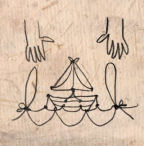

The city rising in the painting’s distant background points to human culpability in this tragedy. Loose eggs are too few to restore either horseshoe crabs or red knots, or other shorebirds needing the eggs. Horseshoe crabs lie scattered, their shells empty, numbers depleted. There’s no beach orgy in Essley’s painting. Each bird needs about 400,000 eggs to make its flight to the Arctic and breed. In mysterious synchrony, the knots, following lengthening days, arrive with the horseshoe crabs, to gorge on excess eggs in the sand. Thousands can hug the tide line, crawling over each other, plowing through each other’s nests, exhuming freshly buried, pinhead-size eggs. Horseshoe crabs come ashore to lay their eggs in sand when the water warms, on nights of spring’s highest tides, when the moon is new or full. Some 150,000 red knots once flew through Delaware Bay each spring: today, less than a third remain. Yet, those birds represent not bounty, but scarcity - a remnant of much larger numbers. Today, visitors seeing red knots crowded together, frenetically feeding as they dash back and forth across the sand, may infer a teeming population. Two-thirds of the state’s knots will fly nonstop to the Arctic.Įssley’s painting could be in Delaware Bay, the avian Serengeti of spring shorebird migration along the U.S.


South Carolina continues to be a critical way station for migrating knots scientists there observed a single flock of at least eight thousand birds. This beach could be in South Carolina, where preeminent ornithologists seventy years ago wrote that red knots represented “an untrammeled wildness and freedom that is equaled by few and surpassed by none.” Mirroring John James Audubon’s red knots, an adult in russet breeding plumage and a gray-and-white juvenile, Essley’s painting evokes beaches along the mid-Atlantic in spring, where red knots make one last essential refueling stop on the long flight to their Arctic breeding grounds. Known by many names - playero ártico (Arctic shorebird) in Chile, maçarico-de-papo-vermelho (reddish shorebird) in Brazil, bécasseau maubèche (knot sandpiper) in Quebec, no particular name ( ᓯᔾᔭᕆᐊᖅ, sijjariaq, birds of the beach) in Nunavut - the red knot brings people together along the edge of two entire continents - people dedicated to giving safe passage to a bird whose journey transcends many countries, languages, and cultures. Its extraordinary migration, among the longest of Earth’s avian journeys, stretches almost from pole to pole. Many Americans haven’t heard of, let alone seen, the bird of Janet Essley’s paintings - the red knot (Calidris canutus rufa ), a small shorebird about the size of a robin.


 0 kommentar(er)
0 kommentar(er)
